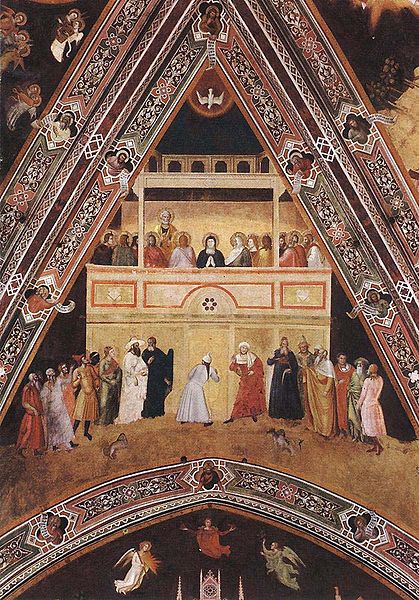 For better viewing click HERE.
For better viewing click HERE.
“Then (after the Ascension) they turned back to Jerusalem from the hill called the Mount of Olives, which is within a Sabbath’s day journey, near Jerusalem. When they entered, they ascended to the upper room where they were staying…” (Acts 1:12-13)
Painting by Andrea da Firenze, 14th c., Descent of the Holy Spirit. The Apostles are in the “upper room” and the Jews are in costumes indicating they had arrived in Jerusalem from different countries (2:5-11). There are many depictions of the Pentecost in art, but this is the only one exactly illustrating the verses in Acts.
There are two questions to be asked about this “upper room”: where was it, and what was its significance? The Greek word in the New Testament is a special and not frequently used term: τὸ ὑπερῷον, “the hypero-on”. “Hyper”, as in hyperactive, or hyperbolic, refers to something over, beyond or above. In ancient Greece, it had referred to the upper part of the house, where the women resided. Here, after the disciples gather after the Ascension, it is where the Holy Spirit descends upon them, on the day of the Pentecost (pictured above). It is also considered the site of the Last Supper, the cenaculum in Latin, along with many other important events described in the NT as happening there. But this particular Greek word occurs only here and once later, in Acts (9:37-40), as the place where Tabitha lies dead until Peter enters and brings her back to life. If one looks for the same word in the Greek version of the Hebrew Bible, the Septuagint (LXX), it refers to a similar miraculous event: in 2 Kings 4:8-17, it is the “upper room” which the Shunamite woman prepares for Elisha in her house, where he announces to her that she will give birth. And then what happens? This very son later becomes ill and dies, is placed back in the “upper room” on the bed of the “Man of God”. Elisha is summoned, enters, and brings him back to life with his breath! So, it is the womens’ room, the space where the Holy Spirit descends and the site of healing breath and resurrection. This can’t be coincidental. It is indeed a “hyper” room, above and beyond this world.
An important note from Dr. Eli: Judith Green (the author of this article) is also the principle author of Biblical Greek course that is being offered now through eTeacherBiblical. To explore the possibility of taking a course in Biblical Greek, please, click HERE.
Today, the upper room is in a 12th c. Crusader structure, built on the upper level above the supposed “tomb of King David”, called a “cenotaph”, from the Greek κενός + τάφος, meaning “empty tomb” – which it is, as the Crusaders put an empty sarcophagus there, since the original tomb had disappeared. According to the Hebrew Bible, David had been buried in the “City of David” presumably to the southeast of the Old City (I Kings 2:10). The tomb of David itself was probably destroyed at the time of the Bar Kokhba revolt (135 C.E.), and afterward the exact location of the site was forgotten.
In Part Two, we will hear more about the history of this building and why the “upper room” was above the “lower room”, the cenotaph of King David. Stay tuned it will be published next week.
To explore the possibility of taking a course in Biblical Greek, please, click HERE.






This is why I love your website, blogs and courses….they bring a breadth of information otherwise not part of traditional Christian teachings…..we’ve been robbed of the history and authenticity of the Hebrew and Christian scriptures. Thank you, Dr. Eli !! : – )
Dear Sheila, so glad to hear this. Spread the word, don’t let others be int he same boat. We have lots of good stuff here on the blog. Share it!
Yes…i share…share…share…Facebook…email…and face to face…..yesterday over the phone shared with credit card account manager eho said my payment with eHebrew went through…good opportunity …she loves the dtoy of the Ten Commandments but doesn’t know why she does….she said she would look into hour classes…loves archeology….gave her hour website to browse.
Thank you so much!
Great job
Judith is great indeed.
You are right, Ann, and I think it has a very strong historical case, within the limits of archaeological evidence. A Syriac inscription of the sixth century discovered there in 1940 says: “This is the house of Mary, mother of John also called Mark. The apostles consecrated it as a Church after the name of Mary the God-bearer. It was built in 73 A.D. after King Titus destroyed Jerusalem”. When the Persians attacked Jerusalem in AD 614 this, ‘Mother of all Churches’ was also destroyed. It was rebuilt several times after that and is still in use, the present building dating from the 12 th c. A very worthwhile site to visit in Jerusalem, using the oldest form of Christian liturgy still surviving. For a very complete re-consideration of the archaeological evidence for the various theories, including the House of Mary Mother of Mark, see http://www.bibarch.com/Perspectives/Germano-Cenacle-Paper.pdf.
What is your opinion of the other contender for the upper room? The Syrian Church of St Mark, which seems to have a very ancient history.
Ann